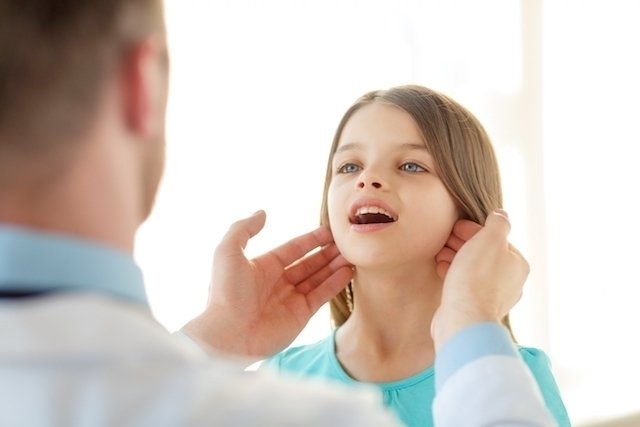Burkitt’s lymphoma is a type of cancer of the lymphatic system, which particularly affects lymphocytes, which are the body’s defense cells. This cancer may be associated with infection by the Epstein Barr virus (EBV), the human immunodeficiency virus (HIV), but it may also arise from some genetic alteration.
Generally, this type of lymphoma develops more in male children than in adults and more frequently affects organs in the abdominal region. However, as it is an aggressive cancer, in which cancer cells grow rapidly, it can affect other organs, such as the liver, spleen, bone marrow and even the bones of the face.
The first sign of Burkitt’s lymphoma is the appearance of lumps in the neck, armpits, groin or swelling in the belly or face, depending on the location affected by the lymphoma. After evaluating the symptoms, the hematologist will confirm the diagnosis through biopsy and imaging tests. Therefore, once Burkitt’s lymphoma is confirmed, the most appropriate treatment is indicated, which is generally chemotherapy. See more about how chemotherapy is performed.

Main symptoms
The symptoms of Burkitt’s lymphoma can vary depending on the type and location of the tumor, but the most common symptoms of this type of cancer are:
- Lumps in the neck, armpits and/or groin;
- Excessive night sweats;
- Fever;
- Weight loss without apparent cause;
- Fatigue.
It is very common for Burkitt’s lymphoma to affect the jaw region and other facial bones, which is why it can cause swelling on one side of the face. However, the tumor can also grow in the abdomen, causing swelling and stomach pain, bleeding and intestinal obstruction. When lymphoma spreads to the brain, it can cause weakness in the body and difficulty walking.
Additionally, the bumps caused by Burkitt’s lymphoma are not always painful and often begin or worsen within just a few days.
What are the causes
Although the causes of Burkitt’s lymphoma are not exactly known, in some situations this cancer is associated with EBV and HIV infections. Furthermore, having a congenital disease, that is, being born with a genetic problem that impairs the body’s defenses, may be linked to the development of this type of lymphoma.
Burkitt’s lymphoma is a type of childhood cancer that is more common in regions where there are cases of malaria, such as Africa, and is also common in other places in the world where there are many children infected with the HIV virus.
How to confirm the diagnosis
As Burkitt’s lymphoma spreads very quickly, it is important to diagnose it as early as possible. The general practitioner or pediatrician may suspect cancer and refer you to an oncologist or hematologist, and after knowing how long ago the symptoms appeared, he or she will recommend a biopsy in the area of the tumor. Find out how a biopsy is performed.
In addition, other tests are performed to diagnose Burkitt’s lymphoma, such as computed tomography, magnetic resonance imaging, pet-scan, bone marrow and cerebrospinal fluid collection. These exams allow the doctor to identify the severity and extent of the disease and then define the type of treatment.

Main types
The World Health Organization classifies Burkitt’s lymphoma into three different types:
- Endemic or African: it mainly affects children aged 4 to 7 years and is twice as common in boys;
- Sporadic or non-African: it is the most common type and can affect children and adults all over the world, accounting for almost half of lymphoma cases in children;
- Associated with immunodeficiency: occurs in people who are infected with the HIV virus and have AIDS.
Burkitt lymphoma can also occur in people who were born with a genetic disease that causes low immunity problems and, sometimes, it can affect people who have had a transplant and who use immunosuppressive medications.
How the treatment is carried out
Treatment for Burkitt’s lymphoma should be started as soon as the diagnosis is confirmed, as it is a type of tumor that grows very quickly. The hematologist recommends treatment according to the location of the tumor and the stage of the disease, but most of the time, treatment for this type of lymphoma is based on chemotherapy.
Medications that can be used together in chemotherapy are cyclophosphamide, vincristine, doxorubicin, dexamethasone, methotrexate and cytarabine. Immunotherapy is also used, with the most commonly used medication being rituximab, which binds to cancer cell proteins helping to eliminate cancer.
Intrathecal chemotherapy, which is the application of medication to the spine, is indicated for the treatment of Burkitt’s lymphoma in the brain and is used to prevent it from spreading to other parts of the body.
However, other types of treatment may be recommended by the doctor, such as radiotherapy, surgery and autologous bone marrow transplant or autotransplant.
Is Burkitt’s lymphoma curable?
Despite being an aggressive type of cancer, Burkitt’s lymphoma is almost always curable, but this will depend on when the disease was diagnosed, the affected area and whether treatment was started quickly. When the disease is diagnosed at an early stage and when treatment begins afterwards, there are greater chances of a cure.
Stage I and II Burkitt’s lymphomas have a cure rate of more than 90%, while stage III and IV lymphomas have an average of 80% chance of cure.
At the end of treatment, it will be necessary to follow up with a hematologist for around 2 years and undergo exams every 3 months.

Sign up for our newsletter and stay up to date with exclusive news
that can transform your routine!
Warning: Undefined array key "title" in /home/storelat/public_html/wp-content/plugins/link-whisper-premium/templates/frontend/related-posts.php on line 12
Warning: Undefined array key "title_tag" in /home/storelat/public_html/wp-content/plugins/link-whisper-premium/templates/frontend/related-posts.php on line 13



